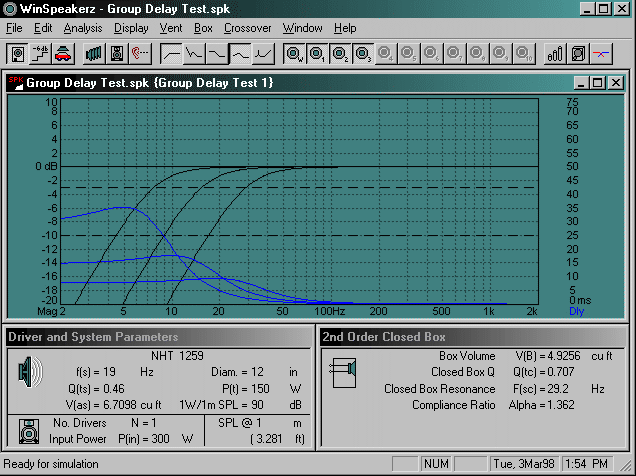|
|
|
|
||||
|
|
|
|
||||
|
The recurring discussion of "fast bass" has led me to suggest that differences in group delay can account for this perceived phenomenon. Below is my recent post followed by comments from David and Dan. At the bottom of the page is a screen shot showing comparisons of the frequency response and group delay for three closed boxes which differ only in their low end bandwidth. Finally, I offer a way to extend the bass of closed boxes using a "Linkwitz Transform" line level equalizer. Here is how the recent discussion went:
Below are three simulated frequency response curves along with their corresponding group delay responses. |

The rightmost curve has a 3 dB corner at about 30 Hz and experiences about 8 msec of group delay at 30 Hz.
The middle curve is a simulation of a similar system (Qtc = .707 for all three cases) but with a corner frequency of 15 Hz. This system has a group delay of 15 msec at its corner frequency but has only 4 msec of delay at 30 Hz.
The third (leftmost curve) system has a corner frequency of 7.5 Hz and while it experiences a full 30 msec of delay at its corner frequency it only has about 2 msec of delay at 30 Hz.
System Corner Frequency Delay at Corner Frequency Group Delay at 30 Hz 30 Hz 8 msec 8 msec 15 Hz 15 msec 4 msec 7.5 Hz 30 msec 2 msec From the table you can see that lowering the corner frequency reduces the group delay of the system at a given pass band frequency (30 Hz in this example). I suggest that the 7.5 Hz system would have what many would perceive as "faster" bass than the 30 Hz system. But it is not a fast rise time that we need for "fast" bass. As David has pointed out, the systems rise time only relates to the high frequency bandwidth of the driver. Rather, I suggest that the physical variable that corresponds to perceived "fast bass" is group delay in the bass range. The less delay the better. Ideally the low frequency components of the program signal would experience NO DELAY compared to the mids and highs.
One way to experiment with very low corner frequencies in closed boxes that does not require the "brute force" of a huge enclosure is to apply a line level "Linkwitz Transform" to the system. This is a simple one op-amp stage that neutralizes the existing 2nd order high pass response and then imposes a new (lower corner frequency and new Qtc) high pass response. Think of it as surgically precise equalization. You can read the details about this circuit in Speaker Builder issue 4/1980. Here's the circuit to show you the idea:
Say your existing closed box is is characterized as: Fsc = 40 Hz and Qtc = .95.
You can use the above circuit to change the response to Fsc = 20 Hz with Qtc = .5
...or to any other Fsc and Qtc.
I have created an Excel spreadsheet that calculates the values for the above "Linkwitz Transform" circuit. You can download it here: Linkwitz Transform Spreadsheet
Also, see my new Tech Topic: Designing a Linkwitz Transform Circuit
Enjoy these new bass response possibilities!
John
john.murphy@trueaudio.com
|
|
|
True
Audio Home Page | Catalog | Tech
Topics | Audio Links | Book
Store Your comments are welcome at webmaster@trueaudio.com |